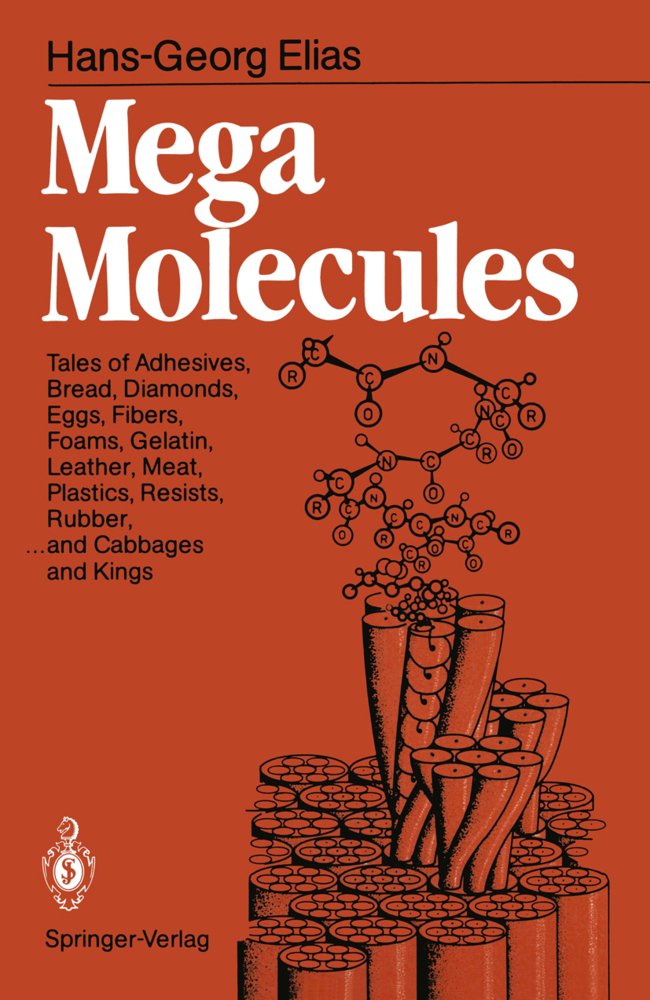Mega Molecules
Tales of Adhesives, Bread, Diamonds, Eggs, Fibers, Foams, Gelatin, Leather, Meat, Plastics, Resists, Rubbers, . . . and Cabbages and Kings
Mega Molecules
Tales of Adhesives, Bread, Diamonds, Eggs, Fibers, Foams, Gelatin, Leather, Meat, Plastics, Resists, Rubbers, . . . and Cabbages and Kings
All life is based on big molecules, scientifically called "mac romolecules". Humans, animals, and plants cease to exist without these structural, reserve, and transport molecules. No life can be propagated without macromolecular DNA and RNA. Without macromolecules, we would only dine on water, sugars, fats, vitamins and salts but had to relinquish meat, eggs, cereals, vegetables, and fruits. We would not live in houses since wood and many stones consist of macromole cules. Without macromolecules, no clothes since all fibers are made from macromolecules. No present-day car could run: All tires are based on macromolecules. Without macromole cules no photographic films, no electronics ... If macromolecules are so important then why is commonly so little known about their roles and why are they so little mentioned in school, if at all? As often in human history, tra dition is important and science makes no exception. Chemis try was established as the chemistry of low molecular weight compounds since these were most easy to investigate, charac terize, and convert. A beautiful tower of thought was erected by the chemical sciences long before the idea of giant mole cules, macromolecules, took hold. There was no space for newcomers in this tower. Even today one can learn about chemistry without hearing a word about macromolecules.
2.1 From Rubber to Elastomers
2.2 Cotton and Its Children
2.3 The First Plastics
3 How Big is Big?
3.1 Atoms and Molecules
3.2 Chemical Elements and Compounds
3.3 Valences and Bonds
3.4 Isotopes
3.5 Masses and Molar Masses
4 False Doctrines
4.1 The Discovery of Polymerizations
4.2 Carbon Chains
4.3 What is a Polymer?
4.4 Necessity Fathers Inventions
5 The Mysterious Crazy Glue
5.1 Macromolecules Step by Step
5.2 The Art of High Conversions
5.3 Macromolecules in One Stroke
5.4 Giants and Their Functionalities
6 Corn Syrup and Hi-Tech
6.1 Grass and Card-Board
6.2 Sweet Potatoes and Tough Meat
6.3 Plastics Waste and Electronics
7 Engine Oils and Vanilla Sauces
7.1 Leftists are Less Preferred
7.2 Coils
7.3 Secrets of Engine Oils
8 Screwing Up Things
8.1 Deterministic Coincidences
8.2 Tactful Molecules
8.3 Helices and No End
8.4 Expedient Packaging
8.5 Foaming Spaghetti and Bursting Eggs
8.6 TV Dinners and Stale Bread
9 Spiders, Weavers, and Webs
9.1 Silk, Artificial Silk, and Polyester
9.2 Wool, Cotton, and Acrylics
9.3 Paper and Leather
10 How to Iron Correctly
10.1 Glasses and Glass Transitions
10.2 Ironing and Shaving
10.3 Plasticizers
11 From Cheap Substitutes to High Performance Materials
11.1 Thermoplastics and Thermosets
11.2 Stronger than Steel
11.3 Unity Creates Strength
12 Everything Flows
12.1 Deborah and the Tennis Rackets
12.2 Entangled Knee-Joints
12.3 Rubbers, Gums, and Elastomers
12.4 Physical Vulcanizations
13 In and Out
13.1 From Moses to Marmelade
13.2 Dreaming of Better Foams
13.3 All the Things One Packages
13.4 Sticking Together and Holding Apart
14 Charges andCurrents
14.1 Siemens Inverts Ohm
14.2 Insulators and Xerox
14.3 How to Convert Insulators into Conductors
Suggested Readings
SI Prefixes and Common Names of Numbers
Physical Units in the SI System
Conversion of Some Anglo-Saxon Units
Symbols, Names, Atomic Numbers, and Relative Atomic Masses of Chemical Elements
Some Trade Names and Trivial Names of Polymers.
1 Genuine Plastics and Other Natural Products
2 In the Beginning was the Deed2.1 From Rubber to Elastomers
2.2 Cotton and Its Children
2.3 The First Plastics
3 How Big is Big?
3.1 Atoms and Molecules
3.2 Chemical Elements and Compounds
3.3 Valences and Bonds
3.4 Isotopes
3.5 Masses and Molar Masses
4 False Doctrines
4.1 The Discovery of Polymerizations
4.2 Carbon Chains
4.3 What is a Polymer?
4.4 Necessity Fathers Inventions
5 The Mysterious Crazy Glue
5.1 Macromolecules Step by Step
5.2 The Art of High Conversions
5.3 Macromolecules in One Stroke
5.4 Giants and Their Functionalities
6 Corn Syrup and Hi-Tech
6.1 Grass and Card-Board
6.2 Sweet Potatoes and Tough Meat
6.3 Plastics Waste and Electronics
7 Engine Oils and Vanilla Sauces
7.1 Leftists are Less Preferred
7.2 Coils
7.3 Secrets of Engine Oils
8 Screwing Up Things
8.1 Deterministic Coincidences
8.2 Tactful Molecules
8.3 Helices and No End
8.4 Expedient Packaging
8.5 Foaming Spaghetti and Bursting Eggs
8.6 TV Dinners and Stale Bread
9 Spiders, Weavers, and Webs
9.1 Silk, Artificial Silk, and Polyester
9.2 Wool, Cotton, and Acrylics
9.3 Paper and Leather
10 How to Iron Correctly
10.1 Glasses and Glass Transitions
10.2 Ironing and Shaving
10.3 Plasticizers
11 From Cheap Substitutes to High Performance Materials
11.1 Thermoplastics and Thermosets
11.2 Stronger than Steel
11.3 Unity Creates Strength
12 Everything Flows
12.1 Deborah and the Tennis Rackets
12.2 Entangled Knee-Joints
12.3 Rubbers, Gums, and Elastomers
12.4 Physical Vulcanizations
13 In and Out
13.1 From Moses to Marmelade
13.2 Dreaming of Better Foams
13.3 All the Things One Packages
13.4 Sticking Together and Holding Apart
14 Charges andCurrents
14.1 Siemens Inverts Ohm
14.2 Insulators and Xerox
14.3 How to Convert Insulators into Conductors
Suggested Readings
SI Prefixes and Common Names of Numbers
Physical Units in the SI System
Conversion of Some Anglo-Saxon Units
Symbols, Names, Atomic Numbers, and Relative Atomic Masses of Chemical Elements
Some Trade Names and Trivial Names of Polymers.
Elias, Hans-Georg
| ISBN | 978-3-540-17541-4 |
|---|---|
| Artikelnummer | 9783540175414 |
| Medientyp | Buch |
| Copyrightjahr | 1987 |
| Verlag | Springer, Berlin |
| Umfang | XIII, 202 Seiten |
| Abbildungen | XIII, 202 p. 7 illus. |
| Sprache | Englisch |











